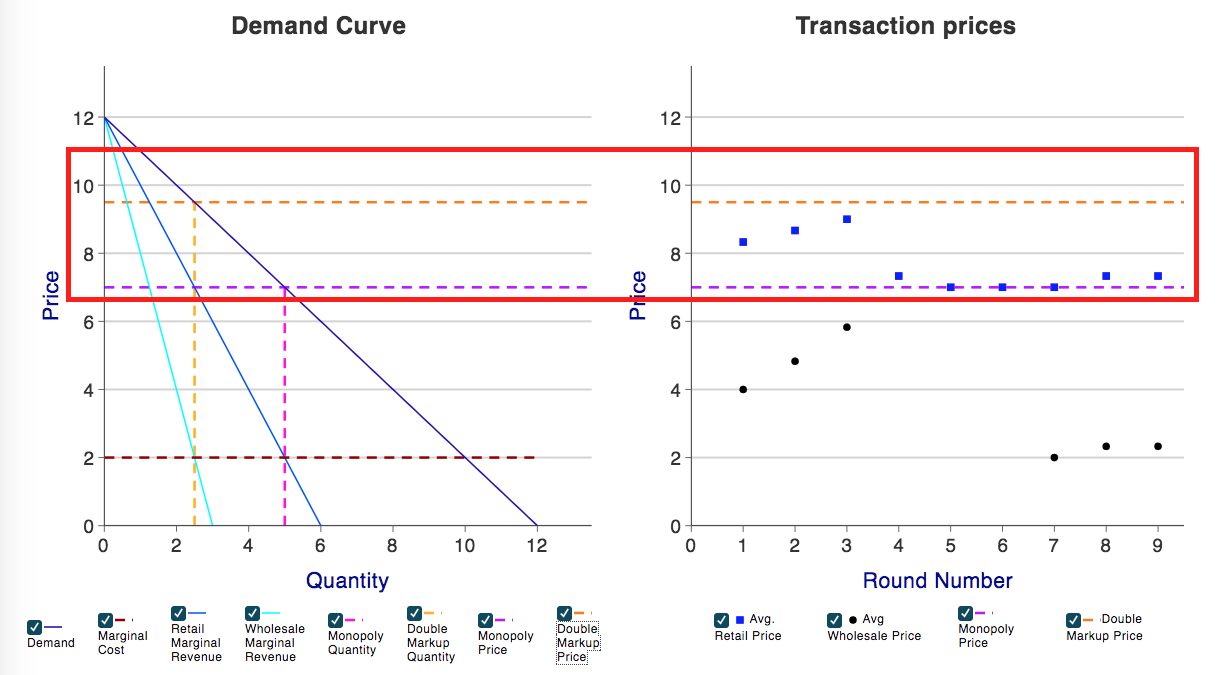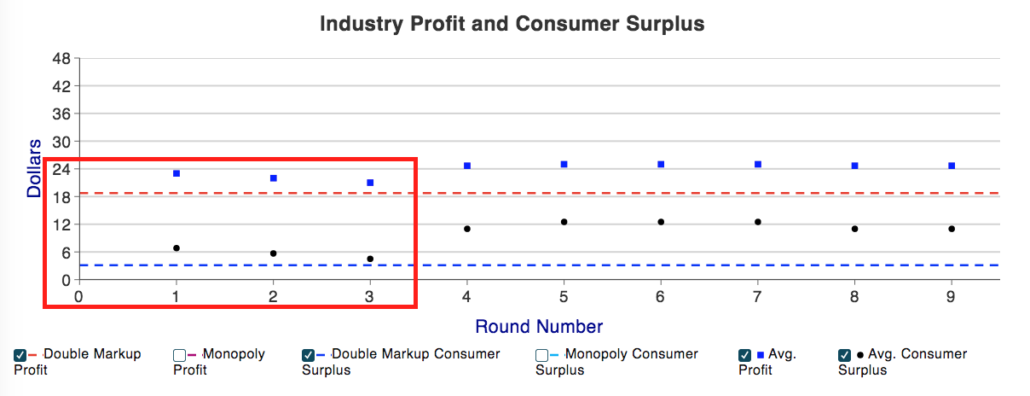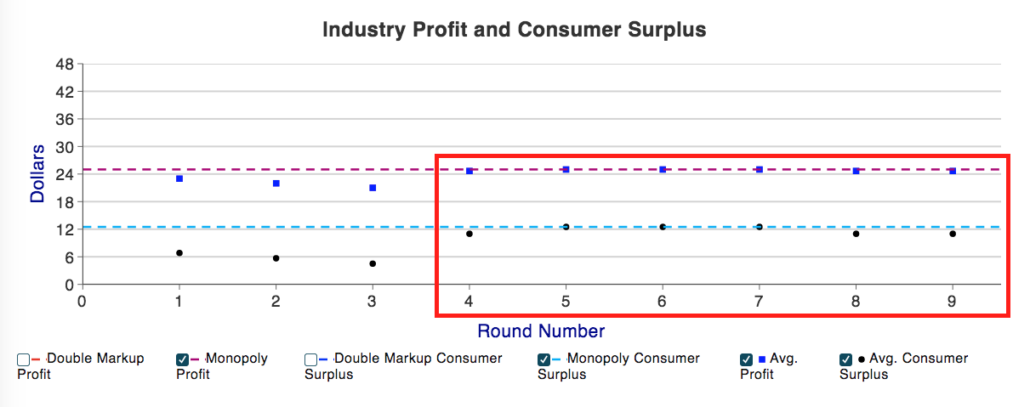The concept of double marginalization can be tricky for students to grasp. How is it possible that mergers improve both industry profits and increase consumer welfare at the same time? In a newly developed game we explore this double marginalization problem. Students act as either a wholesale coffee roaster or a retail café (shown below). Wholesalers set a price per bag of coffee. Given that price retailers decide how much to buy. Beyond experiencing the double marginalization problem we also make it so instructors can allow for the possibility of vertical integration or franchising.With the vertical integration setting each round we allow for free form bargaining. The retailer and wholesaler can both submit offers to acquire each other. Offers can be accepted or declined. When an offer is accepted the acquired firm receives payment equal to the proposal and the merged firm faces market demand as a monopolist. When an offer is rejected there are opportunities to continue to make counteroffers. However, if no agreement is reached when time expires both the wholesaler and retailer will receive nothing. In the franchise setting each round we allow the wholesaler to offer a two-part deal to the retailer. First, the wholesaler sets a one-time franchise fee. Second, the wholesaler sets a price for the retailer to purchase bags of coffee. The retailer can accept or decline any offer. When an offer is accepted the franchisee chooses a quantity to purchase at the wholesaler’s price and also pays the one-time franchise fee. When an offer is rejected the wholesaler can make additional offers. However, if no agreement is reached when time expires both the wholesaler and retailer will receive nothing.Below is some data generated from the game. Rounds 1-3 were no integration rounds. Rounds 4-6 allowed for vertical integration. Rounds 7-9 allowed for franchise contracts. In the graph below the orange line indicates the equilibrium retail price under no integration (i.e. double mark up). The fuscia line indicates the monopoly equilibrium price. In Rounds 1-3 students are trending towards the double mark up equilibrium. In Rounds 4-9 when mergers or franchises are allowed students pretty quickly find the equilibrium monopoly price.
Beyond experiencing the double marginalization problem we also make it so instructors can allow for the possibility of vertical integration or franchising.With the vertical integration setting each round we allow for free form bargaining. The retailer and wholesaler can both submit offers to acquire each other. Offers can be accepted or declined. When an offer is accepted the acquired firm receives payment equal to the proposal and the merged firm faces market demand as a monopolist. When an offer is rejected there are opportunities to continue to make counteroffers. However, if no agreement is reached when time expires both the wholesaler and retailer will receive nothing. In the franchise setting each round we allow the wholesaler to offer a two-part deal to the retailer. First, the wholesaler sets a one-time franchise fee. Second, the wholesaler sets a price for the retailer to purchase bags of coffee. The retailer can accept or decline any offer. When an offer is accepted the franchisee chooses a quantity to purchase at the wholesaler’s price and also pays the one-time franchise fee. When an offer is rejected the wholesaler can make additional offers. However, if no agreement is reached when time expires both the wholesaler and retailer will receive nothing.Below is some data generated from the game. Rounds 1-3 were no integration rounds. Rounds 4-6 allowed for vertical integration. Rounds 7-9 allowed for franchise contracts. In the graph below the orange line indicates the equilibrium retail price under no integration (i.e. double mark up). The fuscia line indicates the monopoly equilibrium price. In Rounds 1-3 students are trending towards the double mark up equilibrium. In Rounds 4-9 when mergers or franchises are allowed students pretty quickly find the equilibrium monopoly price. Another one of our graphs provides equilibrium consumer surplus and industry profits (combined profits from wholesaler and retailer) benchmarks and graphs average behavior across rounds. The first graph shows the equilibrium consumer surplus and industry profits in the case of double mark up and highlights average data from Rounds 1-3. The second graph shows the equilibrium consumer surplus and industry profits when contractual solutions to the double mark up problem are permitted and highlights average data from Rounds 4-9. You can see tendency toward the equilibria in both cases.
Another one of our graphs provides equilibrium consumer surplus and industry profits (combined profits from wholesaler and retailer) benchmarks and graphs average behavior across rounds. The first graph shows the equilibrium consumer surplus and industry profits in the case of double mark up and highlights average data from Rounds 1-3. The second graph shows the equilibrium consumer surplus and industry profits when contractual solutions to the double mark up problem are permitted and highlights average data from Rounds 4-9. You can see tendency toward the equilibria in both cases.
 Those graphs really help to show students the counterintuitive result rather than just tell them about it. So please check out our Double Marginalization game in the instructor console and let us know what you think. Happy playing!
Those graphs really help to show students the counterintuitive result rather than just tell them about it. So please check out our Double Marginalization game in the instructor console and let us know what you think. Happy playing!
 Beyond experiencing the double marginalization problem we also make it so instructors can allow for the possibility of vertical integration or franchising.With the vertical integration setting each round we allow for free form bargaining. The retailer and wholesaler can both submit offers to acquire each other. Offers can be accepted or declined. When an offer is accepted the acquired firm receives payment equal to the proposal and the merged firm faces market demand as a monopolist. When an offer is rejected there are opportunities to continue to make counteroffers. However, if no agreement is reached when time expires both the wholesaler and retailer will receive nothing. In the franchise setting each round we allow the wholesaler to offer a two-part deal to the retailer. First, the wholesaler sets a one-time franchise fee. Second, the wholesaler sets a price for the retailer to purchase bags of coffee. The retailer can accept or decline any offer. When an offer is accepted the franchisee chooses a quantity to purchase at the wholesaler’s price and also pays the one-time franchise fee. When an offer is rejected the wholesaler can make additional offers. However, if no agreement is reached when time expires both the wholesaler and retailer will receive nothing.Below is some data generated from the game. Rounds 1-3 were no integration rounds. Rounds 4-6 allowed for vertical integration. Rounds 7-9 allowed for franchise contracts. In the graph below the orange line indicates the equilibrium retail price under no integration (i.e. double mark up). The fuscia line indicates the monopoly equilibrium price. In Rounds 1-3 students are trending towards the double mark up equilibrium. In Rounds 4-9 when mergers or franchises are allowed students pretty quickly find the equilibrium monopoly price.
Beyond experiencing the double marginalization problem we also make it so instructors can allow for the possibility of vertical integration or franchising.With the vertical integration setting each round we allow for free form bargaining. The retailer and wholesaler can both submit offers to acquire each other. Offers can be accepted or declined. When an offer is accepted the acquired firm receives payment equal to the proposal and the merged firm faces market demand as a monopolist. When an offer is rejected there are opportunities to continue to make counteroffers. However, if no agreement is reached when time expires both the wholesaler and retailer will receive nothing. In the franchise setting each round we allow the wholesaler to offer a two-part deal to the retailer. First, the wholesaler sets a one-time franchise fee. Second, the wholesaler sets a price for the retailer to purchase bags of coffee. The retailer can accept or decline any offer. When an offer is accepted the franchisee chooses a quantity to purchase at the wholesaler’s price and also pays the one-time franchise fee. When an offer is rejected the wholesaler can make additional offers. However, if no agreement is reached when time expires both the wholesaler and retailer will receive nothing.Below is some data generated from the game. Rounds 1-3 were no integration rounds. Rounds 4-6 allowed for vertical integration. Rounds 7-9 allowed for franchise contracts. In the graph below the orange line indicates the equilibrium retail price under no integration (i.e. double mark up). The fuscia line indicates the monopoly equilibrium price. In Rounds 1-3 students are trending towards the double mark up equilibrium. In Rounds 4-9 when mergers or franchises are allowed students pretty quickly find the equilibrium monopoly price. Another one of our graphs provides equilibrium consumer surplus and industry profits (combined profits from wholesaler and retailer) benchmarks and graphs average behavior across rounds. The first graph shows the equilibrium consumer surplus and industry profits in the case of double mark up and highlights average data from Rounds 1-3. The second graph shows the equilibrium consumer surplus and industry profits when contractual solutions to the double mark up problem are permitted and highlights average data from Rounds 4-9. You can see tendency toward the equilibria in both cases.
Another one of our graphs provides equilibrium consumer surplus and industry profits (combined profits from wholesaler and retailer) benchmarks and graphs average behavior across rounds. The first graph shows the equilibrium consumer surplus and industry profits in the case of double mark up and highlights average data from Rounds 1-3. The second graph shows the equilibrium consumer surplus and industry profits when contractual solutions to the double mark up problem are permitted and highlights average data from Rounds 4-9. You can see tendency toward the equilibria in both cases.
 Those graphs really help to show students the counterintuitive result rather than just tell them about it. So please check out our Double Marginalization game in the instructor console and let us know what you think. Happy playing!
Those graphs really help to show students the counterintuitive result rather than just tell them about it. So please check out our Double Marginalization game in the instructor console and let us know what you think. Happy playing!
